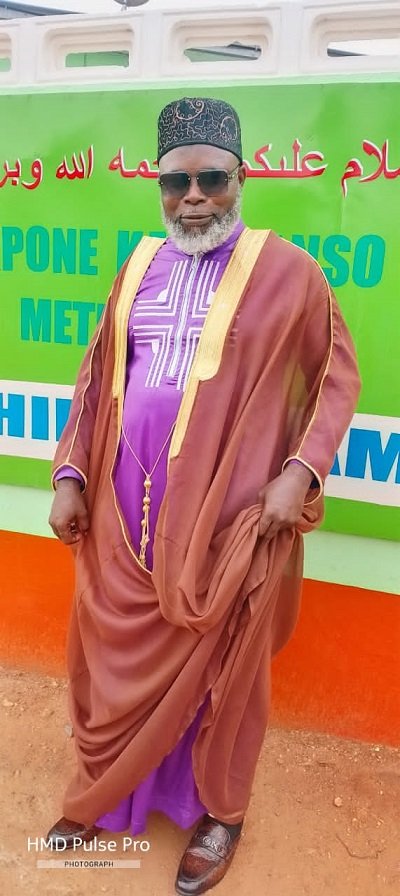Fruitful Living
Do you remember? (Part 1)
“For God did not send His Son into the world to condemn the world, but to save the world through Him.” —John 3:17
INTRODUCTION
This year’s Easter has provided another opportunity for the Christian world to elaborate on the crowning work of our loving Saviour. We spent time to dissect the horrors of the supreme sacrifice that made the positive difference in our eternal destiny. Sermons, songs, and in some cases, the ordinance of foot washing and communion, helped to re-enact the events of the last supper. And once again, we remembered that someone gave His life that we might have everlasting life.
It was a recollection that filled us with dread. For how could a holy God love our sinful human race so much that He put His only begotten Son through that much suffering so that we might be saved? It was also a recollection that filled us with hope. For how could we fear for the future when the crucified Christ rose from the dead and now lives forever?
As the rest of the year stretches ahead of us, if there is one message to keep in mind, it is that Jesus did not die in vain. He died for a purpose, and that purpose extends beyond the Easter holidays. In our key text, we are reminded that He came to save, and not to condemn the world. He has completed His part, and left us to do our part.
As terrible as the pain was, He bore it for our sake. As humiliating and degrading as He was made to feel, He patiently submitted Himself to it all, though He could have called ten thousand angels to slay all those who played principal parts to perpetuate that injustice. He bore it all, so that we can benefit from it. What then are we expected to do in response to such a greatexpression of love?
THE GENERAL RESPONSE
TO CHRIST’S SACRIFICE
We know from Biblical accounts that those who witnessed the crucifixion of Christ did not forget in a hurry. There were those who denied it, knowing in their hearts that they were untrue to compelling evidences and to their own consciences. There were those who had previously doubted, but understood Him clearly only while He was on the cross.
All were touched in irreversible ways. And when Jesus rose again, it was the cue for many to then confess Him as Lord till their last breath.
Jesus did not need to remain physically with them after His resurrection. He had taught them during His three and a half years with them and left them with the Holy Spirit to comfort and guide. His disciples remembered, and the fervor of their witness ignited new generations of other witnesses. They did not just confess Him with their mouths or profess Him merely in their hearts. They did so with their lives. Undaunted by the threat of death, they considered the spilling of their blood a feeble match for the shed blood of God’s Son.
When Peter came face to face with the cross, he saw his unworthiness in stark contrast to the innocence of the One condemned.
When Paul was confronted with the reality of the One who died on the cross, he made a U-turn. Stephen kept his faith to the last, unshaken by the weight of the stones thrown at him, and it did not succeed in shutting out his witness. He breathed his last as a faithful, unrelenting witness of the power of God’s grace. The apostle John died with his belief in the efficacy of the sacrifice of the Son of God.
These men realised how important the issue of salvation is. The recollections of the Roman whip on Jesus’ back, the jeers, and sneers, and shoves—all for a crime He did not commit fired them up. These spoke to them louder and clearer than even Jesus’ words.
Those who were His disciples remembered the times He got hungry and thirsty and tired, all because He wanted to save sinful man. They saw clearly how He went through all of that, by choice, and not because we deserve it.
They remembered how, during the last supper with them, He broke bread and poured wine and commanded them: “Do this in remembrance of me.” As believers, do we remember all these, or have they faded from our memory already, buried under a pile of work and day-to-day concerns?
OUR RESPONSE TO GOD’S LOVE
Remember how on Easter Sunday, we showed up in our Easter clothes and listened with rapt attention to the preacher?
irred deep within us and evoked a commitment to forsake all for the cause of Christ. Just as we were reminded that He died for us, so we are committed to live for Him. Do we still feel the same way today, or have the cares of the week piled on top of the commitment we made? Has it been so long already since that stirring sermon?
Is our life back to the routine of the usual grind? Do we think we can go back to our old way of seeing and doing things? Does Christ’s death and sacrifice impact the choices we make, the friends we keep, how we use our resources, what we eat, and drink, and wear, and how we live our lives?
Do we remember why He died for us? And do we remember that He lives interceding for us so we will not be lost? What has changed about our lives since we pondered the account of Easter this year? Remember, He did not die in vain. Remember, we should not hear the account of His death or profess our belief in His sacrifice in vain. If we recognise that, then we should accept Him as our Lord and Saviour. And if we accept Him as Lord, then we should let Him to have full reign and take charge of our lives.
In closing, Bill Gaither reminds us of our hope as believers in his classic hymn, Because He Lives.
1. God sent His son, they called Him, Jesus; He came to love, heal and forgive;
He lived and died to buy my pardon, An empty grave is there to prove my Saviour lives!
Chorus:
Because He lives, I can face tomorrow, Because He lives, all fear is gone;
Because I know He holds the future, And life is worth the living, Just because He lives!
2. How sweet to hold a newborn baby, And feel the pride and joy he gives;
But greater still the calm assurance: This child can face uncertain days because He Lives!
3. And then one day, I’ll cross the river, I’ll fight life’s final war with pain;
And then, as death gives way to victory, I’ll see the lights of glory and I’ll know He lives!
To be continued!
Stay blessed!
For further inquiries please contact us on Tel Nos. 0243588467 or 0268130615
Email: saltnlightministries@ gmail.com
Website: saltandlightministriesgh.org
By Dr Joyce Aryee, The Author
Fruitful Living
Eid-ul-Adha: A living legacy of faith, sacrifice, and devotion

We begin in the name of Allah, the Most Merciful, the Most Compassionate. We praise Him, seek His help and forgiveness, and seek refuge in Him from the evils of our souls and the wrongs of our actions.
May peace and blessings be upon the Prophet Muhammad (peace be upon him), his family, his noble companions, and all those who follow his path until the Day of Judgment.
Understanding the essence
of Eid-ul-Adha
Eid-ul-Adha, the Festival of Sacrifice, is one of the two major Islamic celebrations observed by Muslims across the world.
It commemorates the unwavering submission of Prophet Ibrahim (Abraham, peace be upon him) to Allah’s command when he was prepared to sacrifice his beloved son Isma’il (Ishmael, peace be upon him). Allah, in His infinite mercy, intervened and replaced the son with a ram, thus honouring Ibrahim’s sincerity and faith.
This moment of sacrifice is recorded in the Qur’an: “Then when they had both submitted and he put him down upon his forehead, We called out: ‘O Ibrahim! You have fulfilled the vision.’ Indeed, We thus reward the doers of good.” (Surah As-Saffat, 37:103–105)
This act of obedience is not merely a historical account. It is a living symbol that forms the essence of Eid-ul-Adha.
Ibrahim (A.S): The Architect
of Submission
Before the moment of sacrifice, Prophet Ibrahim and his family played critical roles in establishing Islam’s foundational pillars:
1. The building of the Ka‘bah
Prophet Ibrahim and his son Isma’il were chosen to construct the Ka‘bah, the sacred House of Allah in Makkah. The Qur’an records this noble moment:
“And [mention] when Ibrahim was raising the foundations of the House and [with him] Isma’il, [saying], ‘Our Lord, accept [this] from us. Indeed, You are the Hearing, the Knowing.’”
(Surah Al-Baqarah 2:127)
This structure remains the spiritual centre of Muslim worship, facing which over a billion Muslims direct their daily prayers.
2. The struggle of Hajar (Hajara) between Safa and Marwa
The mother of Isma’il, Hajar (Hajara), exemplifies a profound lesson of patience and faith. Left in the barren valley of Makkah with her infant, she ran between the hills of Safa and Marwa, desperately searching for water. Her perseverance was rewarded when the well of Zamzam sprang forth at the feet of her baby.
Her sincere struggle is now ritualised in Hajj as the Sa‘i between Safa and Marwa—a reminder of the role of women, the power of du‘a, and the value of trust in Allah’s provision.
Sacrifice at Mina and the
Rites of Jamarat
During Hajj, pilgrims reenact Ibrahim’s confrontation with Shaytan at Mina, where he rejected the devil’s temptation and cast stones at him. This act is now observed in Hajj as the ritual of stoning the Jamarat, symbolising the rejection of evil, temptation, and disobedience.
It is a vivid spiritual lesson: the path to Allah is one of resistance to distraction and sin, and one must be prepared to fight these forces with unwavering faith.
The essence of Arafat in Hajj
The Prophet Muhammad said:“Hajj is Arafah.” (Sunan al-Tirmidhi, 889)
Standing on the plain of Arafat, in deep humility and supplication, is the heart of Hajj. It represents the Day of Judgment, when all of humanity will stand before their Creator. The Prophet said: “There is no day on which Allah frees more people from the Fire than the Day of Arafah.” (Sahih Muslim, 1348)
For pilgrims, Arafat is a time of repentance, reflection, and renewal— and for non-pilgrims, fasting on that day is highly recommended.
Three core lessons from the
Sacrifice of Prophet Ibrahim
(A.S.)
1. Absolute obedience to Allah
Ibrahim’s willingness to sacrifice his son teaches that the essence of faith is unquestioning obedience to Allah. He prioritised divine command over emotion, logic, or comfort.
Takeaway:
In our lives, we must also be ready to put aside our desires, egos, and even attachments if they conflict with Allah’s instructions. This may involve sacrifices such as waking up for Fajr, staying away from haram income, or being truthful in difficult situations.
2. Sincere intention and inner sacrifice
The real essence of the sacrifice lies in the heart’s submission to Allah.
It is neither their meat nor their blood that reaches Allah, but it is your piety that reaches Him.”
(Surah Al-Hajj 22:37)
Takeaway:
Every act of worship should be grounded in sincerity. Whether it is prayer, charity, or sacrifice, what matters most is the purity of our intention.
3. Sacrifice for the greater good
The legacy of Eid-ul-Adha teaches us that sometimes, faith requires us to give up what we love for a greater purpose. Sacrificing wealth, time, or status in the path of Allah or for the benefit of others leads to spiritual elevation.
Takeaway:
Use your resources such as time, money, skills, for acts of benefit: support the poor, educate the young, assist the sick, and build your community.
Celebrating Eid-ul-Adha: A
Festival for all Muslims
Even for those who do not go on Hajj, Eid-ul-Adha holds immense significance. Muslims across the world participate in the act of Qurbani (sacrifice) to honor the tradition of Ibrahim (A.S.).
Types of animals and their
symbolism
Permissible animals include goats, sheep, cows, and camels. Each must meet a minimum age and be free of defects. The sacrificed animal is then divided into three parts: one for the family, one for relatives and friends, and one for the poor and needy.
This distribution reflects the spirit of sharing, compassion, and social responsibility—values at the heart of Islam.
The eternal message of Eid-ul-Adha
Eid-ul-Adha is not merely a celebration; it is a living tradition that calls us to:
• Submit like Ibrahim,
• Strive like Hajar,
• Sacrifice like Isma’il,
• Reflect like the pilgrims at Arafat.
May this Eid awaken within us a renewed commitment to obedience, sincerity, and compassion.
Let us make every Eid-ul-Adha a step forward in our spiritual journey, embodying the values of submission, sacrifice, and service to humanity. I wish every Muslim Eid Mubaarak
By Imaam Alhaji Saeed Abdulai
(Kpone Katamanso Metropolitan Chief Imaam)
Fruitful Living
Steps taken by government to combat illicit drugs (Final part)
The Minister for the Interior, Muntaka Mohammed-Mubarak, has reaffirmed the government’s commitment to combating drug abuse and illicit trafficking for a safer environment which would
go a long way to make Ghana a drug-free country. 3News.com (2025)
Solutions to Illicit Drugs from the Islamic perspective
are comprehensive and emphasise of both prevention and treatment:
Tarbiyah (Islamic nurturing): Instilling strong Islamic values from childhood through Qur’anic education, regular prayer, and association with righteous companions.
Community preaching (Da’wah): Imams must consistently raise awareness during khutbahs and Islamic programs about the dangers of drugs and the beauty of a sober, productive life.
Faith-based rehabilitation: Mosques and Islamic centers can partner with medical institutions to offer Qur’an therapy, spiritual counseling, and structured recovery programs.
Islamic youth clubs: Providing youth with halal entertainment, mentorship, and purposeful engagement can steer them away from harmful peer groups.
Zakat and Sadaqah: Channelling funds to support families of victims and establishing centres for rehabilitation.
Role of Parents, Society, Muslim Chiefs and Imams:
Parents must be vigilant and provide emotional support. A loving, nurturing home reduces a child’s vulnerability to drugs.
Society should de-stigmatize addiction. Drug users should be seen as patients needing healing, not criminals deserving rejection.
Muslim Chiefs must lead community campaigns, setting moral examples and supporting policy enforcement.
Imams must be more than religious leaders—they must become counsellors, educators, and advocates. Their leadership can shift public perception and guide collective action.
Conclusion
Illicit drugs pose one of the most dangerous threats to our society, undermining our religious values, harming our youth, and destroying our future. The Islamic position is clear and
Unequivocal: such substances are forbidden due to their destructive consequences on all aspects of life. Islam does not merely condemn the act but calls for a holistic response—spiritual, social, and structural.
As a society, particularly as Muslims, we must rise to confront this crisis with faith, compassion, and commitment. We must not only preach against drugs but actively work to rehabilitate victims, educate the next generation, and partner with public institutions to create a society of wellness and righteousness.
Recommendations
1. Introduce Islamic drug awareness education in madrasas and public schools, using Quran and Hadith-based materials to instill moral responsibility.
2. Create partnerships between the Ghana Narcotics Control Commission, Ghana Health Service, and Muslim organisations to develop culturally sensitive rehabilitation centres.
3. Train Imams and teachers in basic mental health and drug abuse counselling to serve as front-line responders in communities.
4. Utilise Friday sermons (khutbahs) nationwide to address the dangers of drug abuse periodically and provide practical steps for prevention.
5. Encourage community surveillance, where parents, chiefs, and youth groups report dealers and suspicious activities to the authorities.
6. Establish mentorship programmes in every Muslim community where successful, drug-free role models mentor youth.
7. Form interfaith coalitions, working across religious lines to tackle the drug menace as a national threat rather than a religious issue.
8. Provide job skills training for rehabilitated victims, helping them reintegrate into society and live dignified, self-sufficient lives.
By Imam Alhaji Saeed Abdulai, the Author







